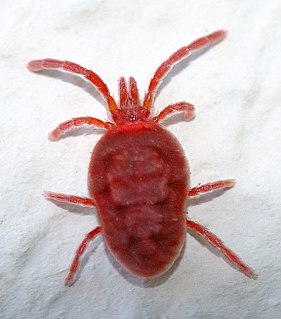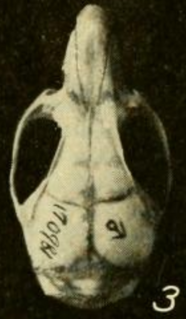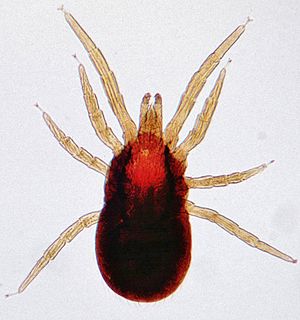
Mites are small arachnids. Mites span two large orders of arachnids, the Acariformes and the Parasitiformes, which were historically grouped together in the subclass Acari, but genetic evidence suggests are not closely related. The Parasitiformes include ticks, which are sometimes semantically distinguished from mites.

Trombicula, known as chiggers, red bugs, scrub-itch mites, or berry bugs, are small arachnids in the Trombiculidae family. In their larval stage, they attach to various animals, including humans, and feed on skin, often causing itching. These relatives of ticks are nearly microscopic, measuring 0.4 mm (0.01 in) and have a chrome-orange hue. A common species of harvest mite in North America is Trombicula alfreddugesi; in the UK, the most prevalent harvest mite is Trombicula autumnalis.
Chiggers are tiny harvest mites, members of the family Trombiculidae, that can cause intense itching and dermatitis.
Acariasis is an infestation with mites.

Transandinomys talamancae is a rodent in the family Cricetidae that occurs from Costa Rica to southwestern Ecuador and northern Venezuela. Its habitat consists of lowland forests up to 1,500 m (5,000 ft) above sea level. With a body mass of 38 to 74 g, it is a medium-sized rice rat. The fur is soft and is reddish to brownish on the upperparts and white to buff on the underparts. The tail is dark brown above and lighter below and the ears and feet are long. The vibrissae (whiskers) are very long. In the skull, the rostrum is long and the braincase is low. The number of chromosomes varies from 34 to 54.
Eutrombicula is a genus of mites in the family Trombiculidae. The species of this genus are found throughout North America, and Australia.

The Prostigmata is a suborder of mites belonging to the order Trombidiformes, which contains the "sucking" members of the "true mites" (Acariformes).
Acarodomatia, are tussocks of hairs or nonglandular trichomes located in pits situated in major leaf vein axes of many plant species, occupied and caused by predatory and mycophagous mites.
Leptotrombidium is a genus of mites in the family Trombiculidae, that are able to infect humans with scrub typhus through their bite. The larval form feeds on rodents, but also occasionally humans and other large mammals. They are related to the harvest mites of the North America and Europe.

Trombiculidae (; commonly referred to as chiggers, but also known as berry bugs, harvest mites, bush-mites, red bugs or scrub-itch mites, are a family of mites. Chiggers are often confused with jiggers - a type of flea. Several species of Trombiculidae in their larva stage bite their animal or human host and by embedding their mouthparts into the skin cause "intense irritation" or "a wheal, usually with severe itching and dermatitis",
Acomatacarus is a genus of mites in the family Trombiculidae. The larvae are parasitic. Species are called also chiggers, scrub itch-mite. The genus includes Acomatacarus arizonensis (lizards), Acomatacarus australiensis, Acomatacarus galli.
Trombicula hirsti is a species in the genus Trombicula, commonly called the scrub-itch mite, it is found in northern Australia.

Trombiculosis is a rash caused by trombiculid mites, which is often referred to as chigger bites.

The Trombidiformes are a large, diverse order of mites.
Many species of arthropods regularly or occasionally bite or sting human beings. Insect saliva contains anticoagulants and enzymes that cause local irritation and allergic reactions. Insect venoms can be delivered by their stingers, which often are modified ovipositors, or by their mouthparts. Insect, spider and scorpion venom can cause serious injury or death. Dipterans account for the majority of insect bites, while hymenopterans account for the majority of stings. Among arachnids spider bites and mite bites are the most common. Arthropods bite or sting humans for a number of reasons including feeding or defense. Arthropods are major vectors of human disease, with the pathogens typically transmitted by bites and rarely by stings or other contact. Another common negative effect is interference with military activity.
Eutrombicula batatas is a species of chigger.

Mites are small crawling animals related to ticks and spiders. Most mites are free-living and harmless. Other mites are parasitic, and those that infest livestock animals cause many diseases that are widespread, reduce production and profit for farmers, and are expensive to control.
Chigger Hill is an unincorporated community in DeKalb County, Alabama, United States.
Eutrombicula samboni is a species of mite in the family Trombiculidae, found in South Australia.
Guntheria coorongensis is a species of mite in the family Trombiculidae, found from the tip of Cape York in Queensland to South Australia.







